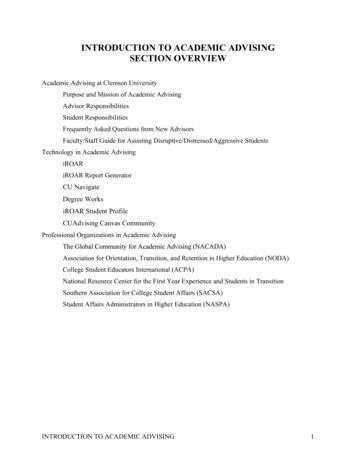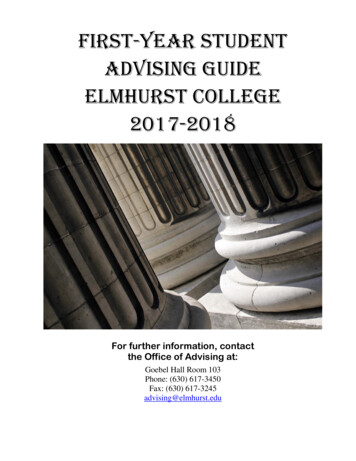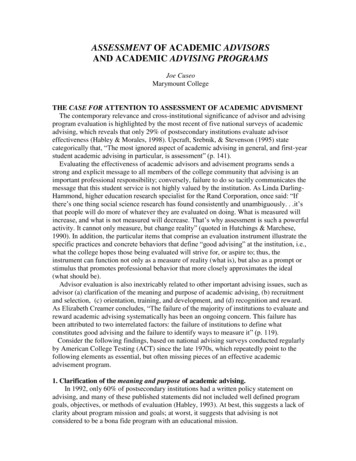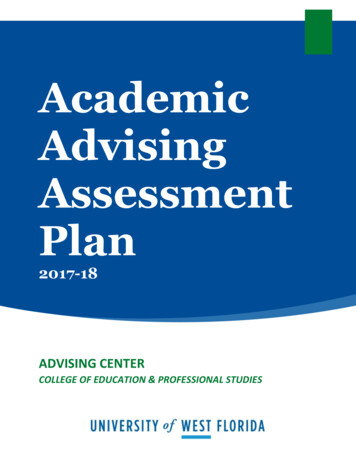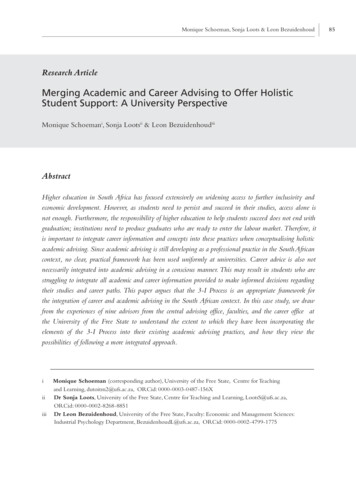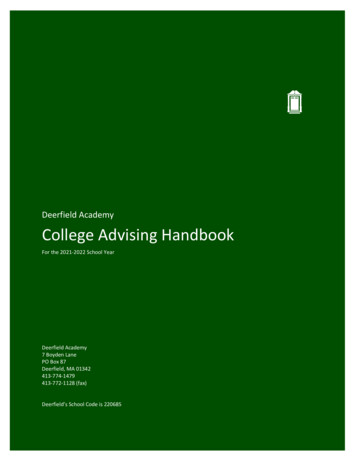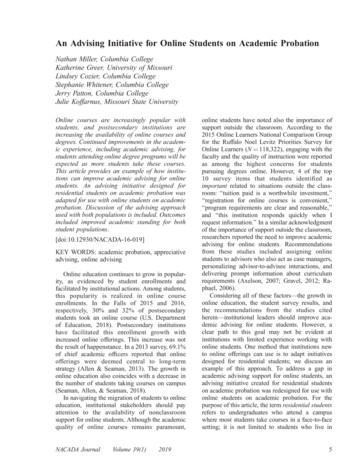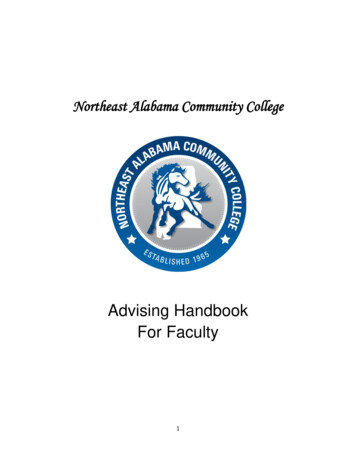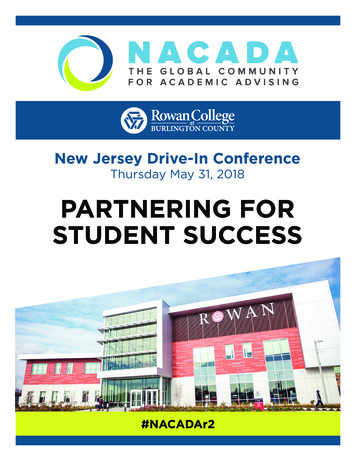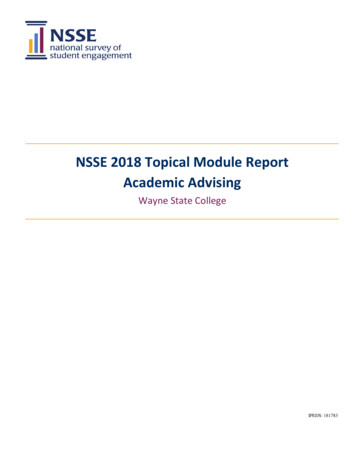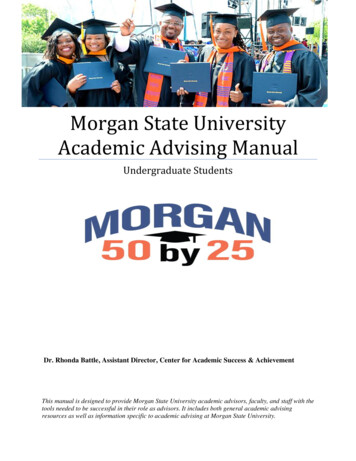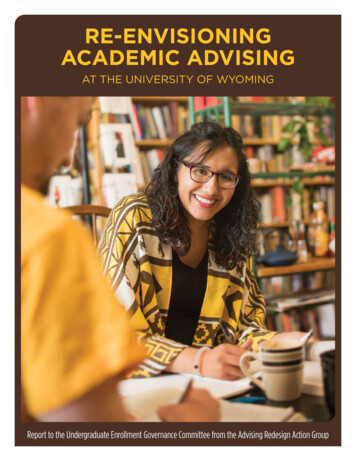
Transcription
RE-ENVISIONINGACADEMIC ADVISINGAT THE UNIVERSITY OF WYOMINGReport to the Undergraduate Enrollment Governance Committee from the Advising Redesign Action Group
EXECUTIVE SUMMARYOriginating in the summer of 2016, the University of Wyoming (UW) engaged in a process to re-envision the currentstructure of Student Advising to address issues confronting student success. With the completion of the StrategicEnrollment Management Plan (SEM Plan) in January of 2017, the Advising Redesign Action Group (ARAG) wastasked by the Undergraduate Enrollment Governance Committee, chaired by Provost Kate Miller, with designing andrecommending strategies and tactics for implementation of a redesigned professional advising system for undergraduatestudents. The aim for the ARAG task force, and its ultimate goal, was and remains to move the needle on retention,progression, and graduation rates in support of the goals laid out in the SEM and the UW Strategic Plans.Currently, the UW advising process is transactional with high variance and inconsistency, negatively impacting studentpersistence to graduation. UW is preparing for significant growth at the undergraduate level over the next five years.Deploying a strong advising model grounded in providing students the information and tools to be successful will resultin their retention and completion. To address the opportunities before us, a centralized advising structure will provideconsistency and accountability for student success, paralleling objectives outlined in the University of Wyoming StrategicPlan. Consultation with key stakeholders across the campus spectrum, including faculty, students, staff, alumni, the Boardof Trustees, and many others, along with research on national best practices has led to this proposal. It is fully vetted andready for implementation beginning with the Fall 2018 Freshmen and Transfer cohorts. This implementation of thisproposal will allow us to accomplish the following: Centralized advising with leadership, training and cohesive communication plans; Consistent advising access across the statewide system with clear points of contact; An advising system that is designed and monitored for equity and inclusiveness; Advising that is centered on student success; and Quality and supportive advisee-advisor relationships.The ability to execute this plan will rely upon hiring a cadre of full-time professional advisors dedicated to year roundengagement and service to students. Focused energy and dedication of these additional personnel will be the cornerstonein delivering the aforementioned objectives. Thus, the foremost need for successful implementation is approval of theproposed program fees by the Board of Trustees during the Fall 2017 semester.Changing academic advising from a transactional action, to serve a utilitarian need, into a model where the student andtheir aspirations is the nucleus of the conversation and individual success the electrical current, will supply the paradigmshift for long term student success and progression to graduation. Urgency of consideration of this proposal is requested.Student success is in the balance, prompting a request for quick and expeditious support for implementation.“Good advising may be thesingle most underestimatedcharacteristic of a successfulcollege experience.”—Richard Light2 RE-ENVISIONING ACADEMIC ADVISING
TABLE OF CONTENTS2Executive Summary4 Re-envisioning Academic Advising at the University of Wyoming4 Introduction5 Needs and Values6 Recommendations7 Why Change? Evidence-Based Practices8 Advising Model Re-Envisioned8 Background and Introduction to the Recommended Undergraduate Advising Model9 Figure 1. Recommended Undergraduate Advising Model10Goal 1. Embrace and Promote a Culture of Student Readiness and Success that Overcomes Barriers11 Goal 2. First-Year Student and First-Semester Transfer Student Advising that is Consistent, Available,and Student Centered12Goal 3. Training and Certification for all Advisors to Ensure Consistency and Accuracy14Goal 4. Clear Governance and Accountability for Advising System16Goal 5. Use Advising Technology and Communications that Promote Student Success17Goal 6. Promoting Engaged Academic and Career Planning18Goal 7. Establishment of Exploratory Studies Tracks19Goal 8. Assessment and Continuous Improvement of Advising System20Timeline21Conclusion22Advising Redesign Action Group23Resources Used and Referenced23Appendix One: Definitions and AcronymsRE-ENVISIONING ACADEMIC ADVISING 3
Re-envisioning Academic Advising at the University of Wyoming: IntroductionPURPOSE AND CHARGEThe University of Wyoming has identified undergraduate advising, with the primary focus on first year and transfer students, as a toppriority for institutional improvement. With the completion of the UW Strategic Enrollment Management Plan (SEM Plan) in Januaryof 2017, the Advising Redesign Action Group (ARAG) was tasked by the Undergraduate Enrollment Governance Committee, chairedby Provost Kate Miller, with designing and recommending strategies and tactics for implementation of a redesigned professional advisingsystem for undergraduate students. The aim for the ARAG task force, and its ultimate goal, was and remains to move the needle onretention, progression, and graduation rates in support of the goals laid out in the SEM and the UW Strategic Plan.In order to elevate impactful undergraduate academic advising and career planning to a level of prominence and focus at the Universityof Wyoming, this report articulates a clear structure designed to ensure student success through the provision of consistent well-trainedadvisors and an evidence-based undergraduate advising system. Ultimately, we believe we should strive for coherent and seamless workacross high schools, UW academic colleges, UW-Casper, and our distance students. We will work to engage our community collegepartners in the implementation of a consistent advising system for shared students of the UW and community colleges.A task force, comprised of experienced and knowledgeable staff and faculty, has met over the past year to evaluate the currentundergraduate advising model, and through this white paper proposes changes that will bring centralized, seamless, uniform and qualityconsistent advising to main campus, UW-Casper and distance students. This model will provide an evidence-based, student-centeredadvising system that will serve all undergraduate students.The charge to the ARAG was to evaluate what the University of Wyoming (UW) does from pre-matriculation, through the key first andsecond years, and continuing through graduation for all populations of UW students. Many UW colleagues work hard to ensure thatstudents: 1) find the right academic/career track; 2) obtain assistance with immediate semester needs; 3) identify a clear graduation path;and 4) achieve post-graduation goals. The team took a 360-degree snapshot of UW’s system and evaluated it against our students’ needs.Given this evaluation, areas of excellence and systemic fixes to pipeline weaknesses have been identified and culminated in these proposedset of recommendations.1 For a list of acronyms and definitions, please see Appendix One.4 RE-ENVISIONING ACADEMIC ADVISING
NEEDS AND VALUESQuality, consistent, mandatory undergraduate advising is imperative to institutional success and student success andsatisfaction. Advisors play key roles in recruitment, retention, persistence, and timely graduation of students. To achievethis, guiding principles have been established and shared across the institution and amongst institutional partners throughthe establishment of the ARAG, We recommend a model that is grounded in the following guiding principles: Centralized advising with leadership, training and cohesive communication plans; Consistent advising access across the statewide system with clear points of contact; An advising system that is designed and monitored for equity and inclusiveness; Advising that is centered on student success; and Quality and supportive advisee-advisor relationships.In addition to these principles and aligned with national best-practices, UW’s advising model should: Ensure the availability of high-quality academic advisors throughout the calendar year; Provide consistent academic and career support throughout a student’s university life, Include advising transition points; provide direct and intentional focus on a strong foundation; Ensure a smooth handoffof a student to a different advisor when students progress or a change of major occurs; Include trained and certified professional advisors and faculty advisors/mentors coordinating in an integrated manner; Instill a culture of student responsibility for academic and career planning; Systematically train advisors and assess academic advising effectiveness; Be developmental and intentional in engaging students in the academic planning process.RE-ENVISIONING ACADEMIC ADVISING 5
RECOMMENDATIONSOur recommendations are focused around achieving eight goals that align with the SEM and the UW Strategic Plan:1. GOAL ONE: Embrace and actively promote a culture of student readiness and success that promotes overcoming barriers for allUW students, regardless of location.2. GOAL TWO: Incorporate the principles of consistent, available and student-centered in advising for all first-year student andfirst-semester transfer students.3. GOAL THREE: Provide training and certification for all academic advisors, including professional staff and faculty, to ensureconsistent and accurate academic advising.4. GOAL FOUR: Provide outlines for governance, accountability, and expectations, for first year and transfer advising to include clearpathways for degree completion for continuing students.5. GOAL FIVE: Employ technology and online resources to support effective and efficient advising. Evaluate current technologies andadvising tools for effectiveness and efficiency in the support of academic advising, student success, and retention and degree completion.6. GOAL SIX: Instill a culture of student responsibility for academic and career planning through the expectation that students createa four-year academic and career path plans and engage in other systemic post-graduation planning7. GOAL SEVEN: Offer exploratory studies tracks for first year students that will allow them to choose and succeed in an academicmajor through exploration of a more general field of study.8. GOAL EIGHT: Commit to ongoing and meaningful assessment and continuous improvement of the new advising model.These recommendations are designed to improve student retention, academic progression, performance, and time to graduation. Weproject that the exploratory studies program, including academic and career planning, will significantly reduce the number of times astudent changes majors and reduce the number of students who graduate with excess hours. The proposed model will increase efficiencyand provide clear pathways to completion for students entering as first year or first semester transfer through consistent, available,accurate, effective and student-centered advising.The most noticeable improvements will be achieved through centralized advising overseen by the Advising, Career and ExploratoryStudies Center ACES and supported by an Undergraduate Advising Council, who in conjunction with ACES, will review and evaluateundergraduate academic advising processes, communication and assessment All first year freshmen and first semester transfer studentswill be advised through this model.Our recommendations are predicated on approval of the proposed program and mandatory student fees by the Board of Trustees duringFall semester 2017. The availability of this income is necessary to increase the cadre of professional advisors.6 RE-ENVISIONING ACADEMIC ADVISING
WHY CHANGE?EVIDENCE-BASED PRACTICESAt the most transitional times in a university student’s life – the first semester of a transfer student’s career, and the first yearof the first-year student’s career – students are commonly mystified by the new world they must learn to navigate. Educationtheorist Richard Light maintains that “Good advising may be the single most underestimated characteristic of a successfulcollege experience.” An advisor who can guide the new or transitioning student through the many questions and decisionsof academic life is often a key factor for a student’s ultimate success in college.Proactive advising that is intentional, reliable, and done in partnership with colleges, departments, and faculty has beeninstituted at many four-year universities in the past decade. Significant demographic change experienced by post-secondaryeducational institutions has meant that students from extremely diverse backgrounds, experiences, and expectations nowattend university, and the traditional model of advisors and students meeting once a semester to pick courses simply doesnot work for 21st century students.Intentional advising means working with students with the “goal of developing a caring and beneficial relationship that leadsto increased academic motivation and persistence.” (Varney, 2007). Research on student retention suggests that contact witha significant person within a university is a crucial factor in a student’s decision to remain in college (Heisserer & Parette,2002). Critically, academic advising is the only structured activity in which all students have the opportunity for on-going,one-to-one interaction with a concerned representative of the institution. Therefore, advisors are the people most vital inretention efforts. When advisors make genuine connections with students, they can become the reason a student decides tostay in school and find a viable, sustainable path to graduation and careers. In addition, contacting students in a preventativemode helps them anticipate problems and learn problem-solving skills and strategies (Upcraft & Kramer, 1995).Nationally, multiple coordinated models of advising exist such as one centralized advising office, hybrid shared advisingmodels, and so forth – but in all cases, there are common elements: Professional advisors and faculty mentors are trained in advising policy, curricular issues, all aspects of the transitionto college, and career/post-graduation preparation. They employ national best practices to focus on helping studentsovercome barriers and challenges in order to succeed. Advisors build a relationship with the student. This relationship assists students in navigating their way through new andcomplex processes, helps them select a major best suited to their academic preparation and career aspirations, helps themunderstand how and when to persist in a course integral to success in their major, accumulate the appropriate creditstoward their degree, and take full advantage of financial and wellness support services. The approach is holistic. It is collaborative and integrated, multidisciplinary, and it helps students navigate support systemsbefore they may even know they need them – services including registration, degree planning, counseling, financialaid guidance, academic mentoring and tutoring, internship exploration, international experiences abroad, and careerpreparation. It relies on outstanding and constant collaboration between all parts of campus, and strong communication.It helps identify students who are at risk of falling off track – before they do – and gives them guardrails to get back on.Universities that have adopted campus-wide, proactive advising, or Integrated Planning and Advising for Student Success(IPASS) include many of our peer institutions. Colorado State University, Georgia State, University of New Mexico,Montana State, the University of Colorado, the University of Kansas, New Mexico State, University of Nevada-Reno,North Dakota State, South Dakota State, Oklahoma State, University of Rhode Island, Utah State, and the University ofUtah, among many others, have adopted redesigns similar to those proposed here. First semester and second semester GPAand retention rates as well as progression rates from sophomore to junior and junior to senior year are documentably andsignificantly higher when advising systems are reformed to include integrated and proactive advisingRE-ENVISIONING ACADEMIC ADVISING 7
ADVISING MODEL RE-ENVISIONEDBackground and Introduction to the Recommended Undergraduate Advising ModelPer the Committee’s charge, a 360 snapshot was taken of university-wide advising. Three questions were asked: How doesadvising work in your office? What training is provided? How is advising assessed? This snapshot revealed inconsistentacademic advising models and communication within and across colleges and schools. We also looked at several otherinstitutions’ models for advising as well as national best practices provided from NACADA, the National AcademicAdvising Association. This research provided the basis for the redesigned advising model.The re-envisioned undergraduate advising model is depicted in Figure 1 on the following page and is intended to meetstudents where they are in their academic journey and provide immediate guidance and advising that will progress studentstowards timely degree completion and academic/career success.The model is specifically designed to ensure high-quality advising for the crucial first two semesters for an incoming firstyear student or freshman, and for the crucial first semester of an incoming transfer student. If a transfer student has less than30 credits, they will be provided the same two-semester advising experience as freshmen. This supports the desired outcomeof reducing the incidences of students’ changing majors and/or graduating with hours in excess of their degree requirements.In the model, it is ACES that will possess the expertise and staff to: 1) oversee advising procedures and policies for the UWand UW-Casper campuses, in consultation with an Undergraduate Advising Council; 2) integrate communication plansand regular meetings/workshops to provide cohesiveness and collaboration among all advising teams; 3) ensure consistencyin advising through advisor training and assessment regardless of residence (e.g., within ACES/UW-Casper/colleges/schools/departments); and 4) provide direct attention to incoming undeclared/exploratory freshmen and transfer studentsfor the first year or first semester of their UW academic experiences.At present, UW advisors hold a monthly convening and information-sharing meeting, “Advising Conversations, for peoplewith advising as part of their job description. This is a convenient structure for announcements and presentations, but itsconfiguration limits the chance for professional development and meaningful discussion of emerging advising challenges.To address this limitation, an Undergraduate Advising Council will be established to set and assess campus-wide goalsfor advising, processes, outcomes and technology and review College Advising plans to insure they address the goals ofthe redesign. This group, which will be coordinated and overseen by ACES, should embrace the vision and have a unifiedcommitment to the success of the model. It will be the Advising Council’s work to establish clear goals for advising andassociated metrics, to assess progress on meeting those goals through collection and analysis of data related to the chosenmetrics, and instituting a systematic process of improvement to advising campus-wide as a result of this analysis. Thecouncil will be comprised of one representative from each college/school and distance education. Through out the 2017-18Academic Year, the Advising Council will work in tandem with the ARAG task force to tackle the immense amountof change engendered in this proposal. After the completion of this academic year, however, the Advising Council willreplace ARAG in the SEM committee structure.With the re-envisioned undergraduate model providing a framework to elevate impactful undergraduate advising and careerplanning, eight goals with associated action plans for undergraduate academic advising are proposed.8 RE-ENVISIONING ACADEMIC ADVISING
FIGURE 1. RECOMMENDEDUNDERGRADUATE ADVISING MODELA C E SSTUDENTDIRECT ADVISINGVIRTUAL REALITYCOMMUNICATION PLATFORMIncludes: UW Colleges, UW-Casper andRegional Center Academic Coordinators,SER, ANR, Honors Program, ENR, andExploratory StudiesTechnology platform with successanalytics, scheduling capability,tracking and push notifications, andcase management capabilitiesSUPPLEMENTAL ADVISINGSTUDENT SUPPORTIncludes: SSS, Synergy, Pre-Prof,Athletics, ESL/IAEP, Transfer Center,ROTC, ISS, Veteran’s Center, MCA,and UDSSIncludes: Writing Center, Math Lab, OralCommunications Center, STEP, DOS,Counseling, RLDS, SFA, Registrar,Student Health, and Wellness CenterGoal 1: Embrace and Promote a Culture of Student Readiness and Success that Overcomes BarriersGoal 2: First-Year Student and First-Semester Transfer Student Advising that is Consistent, Available, and Student CenteredGoal 3: Training and Certification For All Advisors to Ensure Consistency and AccuracyGoal 4: Clear Governance and Accountability For Advising SystemGoal 5: Use Advising Technology and Communications that Promote Student SuccessGoal 6: Promoting Engaged Academic and Career PlanningGoal 7: Establishment of Exploratory Studies TracksGoal 8: Assessment and Continuous Improvement of Advising SystemRE-ENVISIONING ACADEMIC ADVISING 9
GOAL 1EMBRACE AND PROMOTEA CULTURE OF STUDENTREADINESS AND SUCCESSTHAT OVERCOMESBARRIERSEmbrace and actively promote a culture of studentreadiness and success that promotes overcoming barriersfor all UW students, regardless of location.Action Plan 1UW main campus advisors, Distance AcademicCoordinators, and UW Casper advisors are the “Faceof UW” to main-campus, location bound studentsand the state’s communities. To operationalize thisrelationship with students who are not on the Laramiecampus, distance advising, training, and assessmentwill focus upon Completion of ACES professional training by allmain campus, Distance Academic Coordinators, andUW-Casper advisors;10 RE-ENVISIONING ACADEMIC ADVISING Required participation in an annual advisor retreat thatbrings together all UW professional advisors, distanceadvising coordinators, faculty advisors and selectcommunity college advisors who wish to attend. Assuring representation on the Advising Councilfor area academic and advising coordinators,and participation on a regular basis in AdvisingConversations.The required ACES training and an established AdvisingCouncil and Advising Conversations, will result in: An emphasis on providing excellent customer servicesto students from initial contact with the all advisors,including those on campus and those across the state,until graduation; Comprehensive knowledge among our main and offcampus academic advisors and advising coordinators ofthe available academic programs and support services; More assistance for students in the developmentand ongoing achievement of their educational andprofessional goals; A greater emphasis on academic and career planning; Accountability for recruitment and retention ofstudents;Establishment and attainment of performance metricsrelated to measures of student success and persistence.
GOAL 2FIRST-YEAR STUDENTAND FIRST-SEMESTERTRANSFER STUDENTADVISING THAT ISCONSISTENT, AVAILABLE,AND STUDENT CENTEREDFirst year and first semester transfer advising willincorporate the principles of consistent, available andstudent-success-centered academic advising.Action Plan 2ACES will provide oversight and training to ensureentering UW students, confident in their major, andwho meet program or college requirements will beadvised in the respective college or department advisingcenters for a minimum of their first-year/first-semester.Collectively, designation of specific advising entities asexperts in first-year/first-semester advising will provideconsistent and direct attention to incoming freshmen,transfer students, and their unique needs.Students who are admitted to distance or UW-Casperprograms will be advised by the respective distanceAdvising Coordinator for their program or location.ACES would coordinate and provide training, policiesand communication plans for Advising Coordinators.Laramie campus students who are undeclared, admittedwith support through Synergy, or who do not meet theirrespective college or department admission requirementswill be directly advised through ACES. Students whoenter as undeclared will be able to choose an exploratorystudies track and have opportunities to engage inexperiential activities to expose them to majors andcareers. Each track will focus on providing courseworkthat will meet the USP requirements,address prerequisites for specific colleges/majors and putthem on course to confidently declare a specific major.In lieu of a single facility to house an inclusive campusfirst year advising center, centralized advising will beprovided by professional and trained advisors locatedin specified smaller centers within colleges/schools,ACES, and UW-Casper. Each center will be adequatelystaffed and resourced to meet the guiding principles ofthe undergraduate advising model. As stated, ACESin conjunction with the Undergraduate AdvisingCouncil will oversee this centralized advising model. Itis recommended that future space planning discussionsinclude such a facility.This advising model aligns with the plans in progressfor improvement of the transfer student experiencethrough the Transfer Success Center. Componentsof this proposal developed by that group include1) clear and continuous communication with incomingtransfer students through UW’s customer relationshipmanagement system, including distance students;2) strategic use of scholarships to improve transferstudent numbers; 3) communication with students andadvisors regarding the loading and evaluation of theirtranscripts; 4) articulation coordination utilizing bestpractices; 5) mandatory orientation for transfer students.In addition, the ARAG and ACES will develop of aprocess for clear handoffs based on input from collegesand with the Transfer Success Center. This will includetrigger alerts for academic advisors and departmentsto be alerted once a transfer student has confirmedenrollment, and for academic advisors when enrollmentand transcript loading is complete.RE-ENVISIONING ACADEMIC ADVISING 11
GOAL 3TRAINING ANDCERTIFICATION FOR ALLADVISORS TO ENSURECONSISTENCY ANDACCURACYProvide training and certification for all academicadvisors, including main and off campus professionalstaff and faculty, to ensure consistent and accurateacademic advising.Action Plan 3The basic tenet of this model is consistent advisortraining and assessment provided through ACES,required prior to student information system access, andtracked by ACES staff. The training will incorporateUW specific information and national best-practices.ACES will provide and facilitate the completion ofa multi-level training program for all professional(level 4 certification) and faculty (level 2 certification)undergraduate academic advisors. Community collegepartners will be invited and encouraged to complete thistraining as continuing education.ACES will also be responsible for continuing education(online modules) required once per year. College/school advising teams can submit records of attendanceat professional advising conferences which will beconsidered as a portion of the continuing educationhours. New faculty who advise will be expected tocomplete at least two levels of training within six monthsof their hire date, and department heads will ensurethat this training occurs. Supplemental non-academicadvisors, such as University Disability Support Services12 RE-ENVISIONING ACADEMIC ADVISINGand Multicultural Affairs, should also complete at leasttwo levels of training.Upon completion of Advisor 1 and 2, an advisor will beauthorized to release registration numbers.Levels of training would include topics such as thefollowing:Advisor 1: Advisor Quick StartA 20 minute online module that covers The purposes of mandatory academic advising, Basic understanding of National Academic AdvisingAssociation (NACADA) advising guidelines, How to use the student information system(WyoRecords) Essential policies and procedures, The University Studies Program (USP, UW’s generaleducation program) overview, Family Educational Rights Privacy Act (FERPA)regulations, Construction of reasonable, ethical and legal advisingnotes, and Essential campus resources for referral.This module would also include a self-assessment ofunderstanding on material presented.Advisor 2: Advisor EssentialsThis would entail a 15 hour in-person training onadvising at UW. Material would cover: How to begin and end an advising session, Communicating expectations with students,
USP requirements and detailed understanding ofprogram/major degree requirements in primary areasof responsibilities, DegreeWorks (provides What-If scenarios and degreeevaluations for students considering a major changeand/or mapping courses for completion), Common academic policies and procedures (e.g., forms,FERPA, transfer credit, change of major, how GPA’s areand are not affected by transfer & retake transfer credits,probation, suspension, etc.), Information on university structures, and colleges/schools and majors available at UW, Information on campus academic and non-academicsupport resources, Basic mastery of advising technology and SatisfactoryAcademic Progress (SAP) appeals, Early Alert communications How to map academic and career plans Initial training in the EPIC platform (the learning toolmanaged by ACES that helps students work throughbenchmarks towards academic success and careerplanning) and First Year Seminar advising.All advisors completing this level would b
consistent and accurate academic advising. 4. GOAL FOUR: Provide outlines for governance, accountability, and expectations, for first year and transfer advising to include clear pathways for degree completion for continuing students. 5. GOAL FIVE: Employ technology and online resources to support effective and efficient advising. Evaluate .
